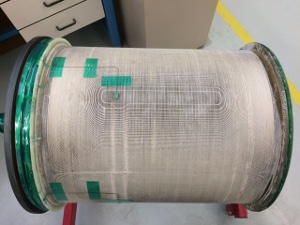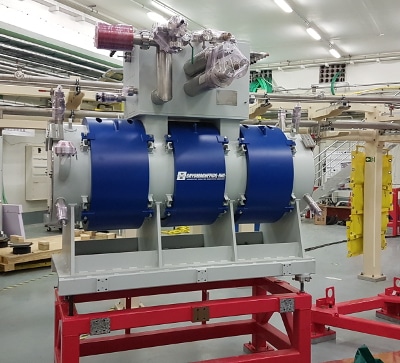- Homepage
- >
- Scientists
- >
- News & Highlights
- >
- 2018
- >
- Arrival of the first Superconducting Multipole Triplet (SMT) in the experimental hall of the Super Separator Spectrometer (S3)
Arrival of the first Superconducting Multipole Triplet (SMT) in the experimental hall of the Super Separator Spectrometer (S3)
August 29, 2018 was an important date for the S3 team, receiving the first of the seven superconducting triplets. The magnet, weighting 2.8 tons and 1.8 meter long, uses an innovative coil design. It is one of the key components of the new spectrometer, due to its ability to correct high order aberrations and its contribution to achieve the expected separation.

Each triplet contains 11 independent functions: 3 quadrupoles, 3 sextupoles, 3 octupoles and 2 dipoles, in a rather compact volume for such a large aperture magnet (30 cm bore aperture). The very well defined magnetic field results of a precise positioning of the different coils in a saddle coil configuration. This is obtained by machining grooves in the fiberglass / epoxy matrix and placing the Nb-Ti thin conductors. High order harmonics in the fringe fields are minimized by the use of a particular disposition of the conductor. (P.Walstrom, NIM-A519 -2004).
The Low Temperature Superconducting part of the magnets operates at 4.2°K, the temperature of Liquid Helium, whereas the 16 High Temperature Superconductor (HTS) current leads are cooled using gaseous Nitrogen, another challenge of the design. Each SMT will dissipate less than 5W of Liquid Helium.

Each set of coils is powered by one of the 7 low-voltage and high current – up to 500 A- Power Supply System (PSS). The quench protection is ensured by monitoring of coils voltages (via the PSS) and, for the quadrupoles, a rapid propagation of any early quench by use of internal dump resistors.
A SMT include a cold box to control the different fluids through 3 main cryogenic valves (Stöhr). The valves are horizontal, due to height restriction in the S3 cave with the use of the crane.
The magnet design is a collaboration between GANIL, CEA/IRFU, Argonne National Laboratory, and the US companies that also are in charge of the fabrication: Cryomagnetics Inc. (OakRidge, TN) for the cryogenics and integration, and AML/SM (Palm Bay, FL) for the coils and power supply systems.

The newly received magnet is the first after the prototype tested at Argonne National Laboratory. It is now installed in the S3 room for the different phases of commissioning.
